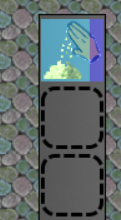I have this strange problem that even after spending like 14 hours in a row i can’t find a way to solve it.
i am trying to make a few pixel shaders functions, and the results are always funny for some reasons, after a lot of testing i found the TEXCOORD0 values range changes based on the original texture size, i read the semantics of TEXCOORD0 is deprecated and i read we should use SV_POSITION instead of POSITION, etc etc etc, anyhow …
This is the shader code i am using
#if OPENGL
#define SV_POSITION POSITION
#define VS_SHADERMODEL vs_3_0
#define PS_SHADERMODEL ps_3_0
#else
#define VS_SHADERMODEL vs_4_0_level_9_1
#define PS_SHADERMODEL ps_4_0_level_9_1
#endif
Texture2D SpriteTexture;
float TimeE; float H;
sampler2D SpriteTextureSampler = sampler_state {
Texture = <SpriteTexture>;
};
struct VertexShaderOutput {
float4 Position : Position;
float4 Color : COLOR0;
float2 uv : TEXCOORD0;
};
float4 ColdDown1(VertexShaderOutput input) : COLOR {
float4 color = tex2D(SpriteTextureSampler, input.uv) * input.Color;
if(input.uv.y >= CD) color.b = color.b + 0.4f;
return color;
}
technique ColorShiftTec {
pass Pass0 { PixelShader = compile PS_SHADERMODEL ColdDown1(); }
};
no matter what i do in the function the result different from online simulators like shadertoy (after i change the terms from GLSL to HLSL manually)
and when i used fixed values like
if(input.TextureCoordinates.x < 0.5) color.g = color.g + 0.2f;
i get different result than the simulated one

after a lot of attempts and tinkering i found out based on the texture i use the values differ, and when i edit the image and change its size i get different results, so i made few tests and here they are:
so if i have a texture with width and height of 4000 the uv respectivly value becomes from 0 to ~0.14438
for texture of size 2000 the uv becomes from 0 to ~0.2896 which is double the value
for size of 1 pixel the uv go to 0 to 579.2 …
i copied the project and test it on a different computer and the results the same. which is kinda a good news cause i can just use magic numbers and pray to God that it wont break or never change atlases sizes, and reconfigure a way to make my effects manager do the calculation after find the exact magical number, but no screw all of that <_<; shouldn’t the TEXCOORD0 have values from 0 to 1?
if anyone have an idea what i am doing i would appricate it, i tried to change the pixel shader but didn’t notice any changes
